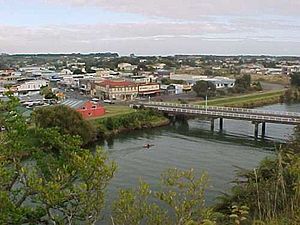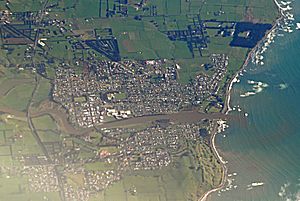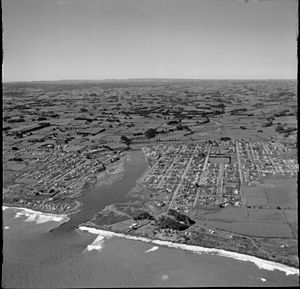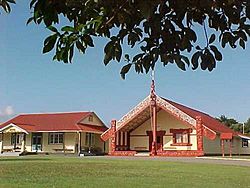Waitara, New Zealand facts for kids
Quick facts for kids
Waitara
|
|
|---|---|

Waitara and the Waitara River
|
|
| Country | New Zealand |
| Region | Taranaki Region |
| Territorial authority | New Plymouth District |
| Ward |
|
| Community | Waitara Community |
| Electorates |
|
| Area | |
| • Total | 6.09 km2 (2.35 sq mi) |
| Population
(June 2023)
|
|
| • Total | 7,550 |
| • Density | 1,239.7/km2 (3,211/sq mi) |
| Postcode(s) |
4320
|
Waitara is a town in the northern part of the Taranaki region on the North Island of New Zealand. It is located just off State Highway 3. Waitara is about 15 kilometers (9 miles) northeast of New Plymouth.
Waitara was where the Taranaki Wars began in 1860. This happened after British settlers tried to buy land from its Māori owners. Arguments over land that the government later took (confiscated) still continue today.
There are a few different stories about how Waitara got its name. One story says it was first called Whai-tara, meaning "path of the dart". This name came from a story where Whare Matangi followed a dart to find his father. Another story says that Turi named it because of his long steps when crossing the river. Some say Turi named it Waitarangia because the cold water affected his skin. Another idea is that it means "mountain stream". In 1867, the town was named Raleigh, after Sir Walter Raleigh. But it went back to its original name, Waitara, in 1904.
Contents
History of Waitara
Early Days in Waitara
Before Europeans arrived, Waitara was on an important travel route. This route connected the Waikato and Taranaki areas. Many old Māori forts, called pā, show that many people lived here. They also show that different tribes often fought over the land.
In the early 1800s, whalers and seal hunters came from other parts of the world. They worked with local Māori. However, in the 1820s and 1830s, many people left the area. This was due to wars between the local Te Āti Awa tribe and tribes from the north. Some Te Āti Awa people were taken as prisoners. Others moved to the Cook Strait area to get guns and goods from traders.
European Settlers Arrive
European settlers, called Pākehā, came to New Plymouth in the 1840s and 1850s. They thought Waitara had the best land in Taranaki. It had fertile soil and a good harbor. The New Zealand Company planned to settle land from New Plymouth to Waitara. They sold land to new settlers. But they did not always have proof that they had bought the land fairly.
The company claimed that Te Āti Awa had left the land or lost it in wars. The Land Claims Commission agreed with this idea at first. But later, Governor Robert FitzRoy and the Waitangi Tribunal disagreed.
The First Taranaki War Begins
Problems between settlers and local Māori started in 1842. Settlers who had taken land north of the Waitara River were forced to leave. A year later, about 100 Māori people sat in the path of surveyors. They wanted to stop the measuring of land for sale.
In 1848, Wiremu Kīngi, a Te Āti Awa chief, returned to Waitara. He strongly opposed selling land in the area. He came back with almost 600 people and animals to reclaim the land. They grew a lot of crops like wheat, oats, and potatoes. They sold these crops to settlers and for export.
Despite Kingi's wishes, government agents secretly paid some Māori individuals for land in Waitara. This caused fights between those who wanted to sell land and those who did not.
The Pekapeka Block Dispute
In 1857, a major issue arose when two individuals offered to sell land. One was Īhāia Te Kirikūmara, and the other was a chief named Pokikake Te Teira. Teira's land, called the Pekapeka block, was 240 hectares (600 acres). It was on the west side of the Waitara River. This block became the main point of disagreement.
The colonial government believed individuals could sell land. But Māori custom said that land belonged to the whole community. This disagreement led to war in Waitara on March 17, 1860. About 500 soldiers began attacking Kingi's Te Kohia pā, a fortified village.
The war lasted 12 months. About 2,300 soldiers fought against 1,400 Māori. A ceasefire was finally agreed upon. During the war, the British suffered a big loss at the Battle of Puketakauere. This battle was near Te Kohia pā.
Land Confiscation and Its Impact
In May 1863, the war started again in Taranaki. The government then took large areas of land. They said this was punishment for certain events. In 1865, the Pekapeka block, which started the first dispute, was taken by the government.
In 1884, the government returned some of the confiscated land to Māori. But this land, called "Native reserves," stayed under government control. By 1990, half of these reserves had been sold to European settlers. This happened without asking Māori. The rest of the land was leased to settlers for very low rent.
The Pekapeka Block was given to the Waitara Borough Council and Taranaki Harbours Board. In 1989, the land went to the New Plymouth District Council. In 2004, the council voted to sell it to the government. The idea was for it to go back to Te Āti Awa as part of a Treaty of Waitangi settlement. However, this was stopped by the High Court in 2005.
Working Towards a Treaty Settlement
In September 1990, the Waitangi Tribunal began looking into 21 claims about the Taranaki area. Much of their work focused on events in Waitara from 1840 to 1859.
The tribunal reported to the government in 1996. They noted that Māori in Taranaki lost their land, leaders, and way of life. They were denied their rights as Māori and as British subjects. The report said that many street names in Waitara honored those who took the land. The tribunal suggested changing these names. They believed this would help end the "Waitara war" and bring peace.
In November 1999, the New Zealand Government agreed to settle claims with Te Āti Awa. This included financial payment and an apology for the land that was taken.
Marae in Waitara
Waitara has two important Māori meeting places, called marae.
- Kairau Marae has the Te Hungaririki meeting house. It is a meeting place for the Pukerangiora hapū (sub-tribe) of Te Āti Awa. In 2020, the government gave money to upgrade this marae. This project also created 15 jobs.
- Ōwae or Manukorihi Marae has the Te Ikaroa a Māui meeting house. It is a marae for the Te Āti Awa hapū of Manukorihi, Ngāti Rāhiri, and Ngāti Te Whiti. In 2020, the government also gave money to upgrade this marae, creating 15 jobs.
Waitara's Population
Waitara covers about 6.09 square kilometers (2.35 square miles). Its estimated population is 7,550 as of June 2023. . This means there are about 1240 people per square kilometer.
At the 2018 New Zealand census, Waitara had a population of 6,918 people. This was an increase of 435 people since the 2013 census. There were 2,613 households. The population included 3,369 males and 3,543 females. About 21.9% of the people were under 15 years old.
Most people in Waitara are European/Pākehā (72.4%). A large number are also Māori (43.1%). Other groups include Pacific peoples (3.5%) and Asian (1.5%).
Waitara's Economy
Early Trade and Industry
Waitara was the first port in Taranaki to trade with other countries. This happened in 1823. A ship called the William Stoveld anchored in the river mouth. It traded with Māori.
In 1872, a freezing works opened. This made the river port even more important. However, the river entrance has a sandbar. Ships could only cross it at high tide. When a breakwater was built in New Plymouth and a railway line opened, Waitara's port became less important.
Construction of a railway line between Waitara and New Plymouth began in 1873. By the time it opened in 1875, Waitara had many businesses. These included a soap factory, an iron foundry, and two breweries.
The Freezing Works and Its Closure
From 1887, Waitara's economy relied on the frozen meat trade. Meat was sent to Great Britain and later to Asian countries. Most of the frozen meat was taken to New Plymouth's port by rail.
In 1902, Thomas Borthwick and Sons bought the freezing works in Waitara. Until 1998, the freezing works was the biggest employer in town. It had between 1,000 and 1,500 workers. In 1990, Borthwicks sold the works to AFFCO Holdings.
In 1995, AFFCO closed the Waitara works. This caused many people to lose their jobs. Other factories, like a clothing factory and a car assembly plant, also closed. The number of unemployed people in Waitara rose sharply. This affected Māori workers the most, as many worked at the freezing works. After the closure, most of the freezing works buildings were taken down. This changed the town's look.
For over 75 years, the freezing works had put waste directly into the Waitara River. This was less than 3 kilometers from the sea. Local Māori said that this pollution harmed their traditional food sources from the sea.
New Industries in Waitara
Today, two large petrochemical plants are important industries in Waitara. The Waitara Valley plant makes methanol from natural gas. The Motunui plant also makes methanol for export. The Motunui plant has two of the largest wooden structures in the Southern Hemisphere.
The town also continues to support the farming industry. Farms in the Waitara area raise dairy cows, beef cattle, and sheep. They also grow fruit like kiwifruit and other plants.
Sports in Waitara
Cricket and Soccer Clubs
The first Waitara Cricket Club started in October 1878. Mr. J. Elliot was the club captain. The club's colors were scarlet and white.
The Waitara Soccer Club was formed in 1905. Their first game was against New Plymouth A.F.C. on May 18, 1905. Waitara won the Julian Cup in its first season.
Education in Waitara
Waitara has several schools for different age groups.
- Waitara High School is the only secondary school (years 9–13) in Waitara. It has 316 students.
- Manukorihi Intermediate is for intermediate students (years 7–8). It has 115 students.
- Waitara Central School and Waitara East School are primary schools (years 1–6). Waitara Central has 111 students, and Waitara East has 210 students.
- St Joseph's School is a full primary school (years 1–8). It is a state-integrated Catholic school with 57 students.
All these schools are for both boys and girls. Student numbers are as of February 2024. .
Notable People from Waitara
- Howie Tamati




